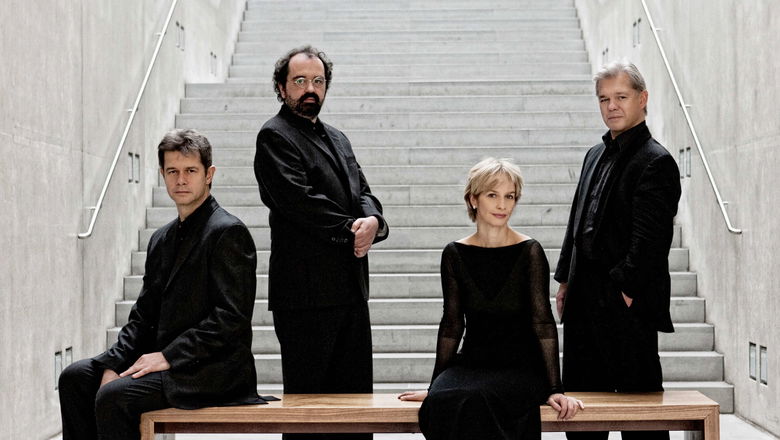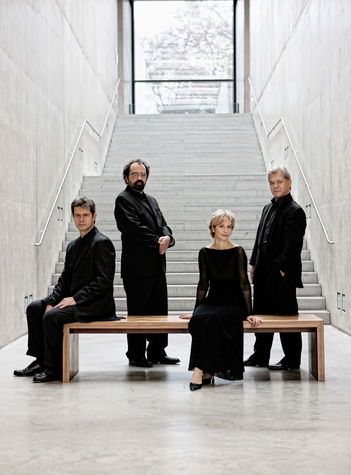1 / 6
Czech Chamber Music Society • Hagen Quartet
Opening Series II of the Czech Chamber Music Society is the famed Hagen Quartet. The concert, cancelled three years ago because of Covid measures, will look back at the recent 250th anniversary of Beethoven’s birth. Lukas, Veronika, and Clemens Hagen and Rainer Schmidt will enchant us with the master’s quartets nos. 8 and 13.
Programme
Ludwig van Beethoven
String Quartet No. 8 in E minor, Op. 59, No. 2 (35')
— Intermission —
String Quartet No. 13 in B flat major, Op. 130 (48')
Performers
Hagen Quartet
Lukas Hagen violin
Rainer Schmidt violin
Veronika Hagen viola
Clemens Hagen cello

The sale of individual tickets for subscription concerts (orchestral, chamber, educational) will begin on 2 June 2025 at 10 a.m.
Individual tickets for all public dress rehearsals will go on sale on 10 September 2025 at 10 a.m.
Customer Service of Czech Philharmonic
Tel.: +420 227 059 227
E-mail: info@czechphilharmonic.cz
Customer service is available on weekdays from 9.00 am to 6.00 pm.
Performers
Hagen Quartett

After concerts by the “four world-class string players from Salzburg” (Hamburger Abendblatt), there is “absolute silence for almost minutes, conscious of having experienced something extraordinary.” All the listeners have in common is “only the wish: may it never end.”
The Hagen Quartetʼs unparalleled career, which has already spanned four decades, began in 1981. The quartet was originally founded by the four Hagen siblings, three of whom are still members today (the violinist Rainer Schmidt became a member in 1987). The first years were marked by competition successes and an exclusive contract with Deutsche Grammophon. During the decades of collaboration, numerous recordings were made to explore the almost endless quartet repertoire, from which the Hagen Quartetʼs unmistakable profile developed. Subsequent recordings on the Myrios Classics label have also received international critical acclaim and major awards. A recording together with Jörg Widmann and clarinet quintets by Widmann and Mozart has just been released.
The quartetʼs repertoire consists of delightful and intelligently combined programmes spanning the entire history of the string quartet, including premieres by composers of its generation. In the 2012/13 season they toured the world with the complete quartets of L. v. Beethoven, some of which they have also successfully recorded during their long-lasting career.
The Hagen Quartet has been an honorary member of the Konzerthaus Wien since 2012 and received the Concertgebouw Amsterdam Prijs in 2019 for its many years of artistic radiance and contribution. As teachers and mentors at the Salzburg Mozarteum, the Hochschule Basel and at international master classes, the members of the quartet pass on this wealth of experience to their younger colleagues.
In addition to the Prague concert, we will hear the Hagen Quartet in Berlin, Paris and Oslo this season. They also embark on tours to Italy, Spain, Japan and the USA, and prepare their own concert series at the Konzerthaus in Vienna.
Compositions
Ludwig van Beethoven
String Quartet No. 8 in E minor, Op. 59, No. 2
Together with his symphonies and piano sonatas, Ludwig van Beethoven’s sixteen string quartets represent one of the main pillars of his oeuvre. They are unique in the context of the entire quartet literature for their musical language, their enormous degree of invention and their demands on the performers. Tonight we will hear String Quartet in E minor, Op. 59, No. 2, from the composer’s middle creative period, and String Quartet in B flat major, Op. 130, written at the end of his life. This quartet has two final movements; the original finale was published separately as Grosse Fuge, Op. 133.
String Quartet in E minor, Op. 59, No. 2 is one of the three quartets which Beethoven composed between 1806 and 1807. Six years had passed since his last work in this field (namely a series of six quartets presented under Op. No. 18), and in the meantime the composer had undergone considerable development in music and thought, creating compositions such as Symphony No. 3 in E flat major “Eroica” and the opera Fidelio. For several years Beethoven had been affected by disabling hearing loss, which was a severe blow forcing him to withdraw more and more from society. All three quartets have a symphonic character and their style and musical language has already departed completely from the quartet music of the 18th century. While most of the previous quartet literature could be played by skilled amateur musicians, with the three quartets, Op. 59, Beethoven has begun an era when the performance required the highest level of mastery.
The introductory movement begins abruptly with two chords (minor and major) followed by a pause. The pianissimo slowly evolves into a theme, but the key changes and the swinging in the sixteenth notes create tension. The contrasting Molto adagio in E major provides the desired reassurance and is undoubtedly one of Beethoven’s most beautiful slow movements ever. According to Carl Czerny, Beethoven’s pupil and friend, Beethoven got the inspiration to write the second movement of the quartet when he contemplated the starry sky and thought of the music of the spheres. It gives the impression of an endless melody that seems to pay tribute to the infinity of the universe and the beauty of nature. The trio of the following movement uses a theme of a Russian folk song. This was a friendly gesture towards the commissioner of the work, Count Rasumovsky, the Russian ambassador to the Viennese court, in whose palace the quartet was premiered. (However, the composer made some mischief to the original lofty theme.) The whole piece concludes with a dance-like light rondo.
Beethoven’s late string quartets form a world of their own. The composer was so ahead of his time that they remained misunderstood and unappreciated by the majority of the musical public for a long time. They were composed between 1824 and 1826, i.e., after his Ninth Symphony. For Beethoven, the string quartets together with his piano sonatas were the means by which he could express his intimate feelings, giving us a glimpse into his innermost world. Compared to the other quartet literature of the time, Beethoven’s late string quartets made much higher demands on the attention and musical maturity of listeners and their polyphonic nature made them difficult to access as well.
Ludwig van Beethoven
String Quartet No. 13 in B flat major, Op. 130
String Quartet in B flat major, Op. 130, designated as the 13th of Beethoven’s quartets, but actually his 14th in order of composition, was dedicated by the composer to the Russian Prince Golitsyn. It is one of the three quartets commissioned by the Prince, an amateur musician himself, in November 1822. The work did not have a simple genesis. The first version saw the light of day in November 1825 after eight months of work. Before it went to print, however, the publisher asked Beethoven to compose a new final movement. He felt that the extensive and complicated fugue was not a good fit for the rest of the work. (At the premiere of the quartet in its original version in March 1826, this movement did not meet with much appreciation. For example, one critic wrote in Allgemeine musikalische Zeitung that he “does not dare to interpret the meaning behind the fugue finale” because for him it was “as incomprehensible as Chinese”.) Beethoven therefore composed a new finale, publishing the fugue as an autonomous piece in 1827 entitled Grosse Fuge in B flat major, Op. 133. (The new final movement marked Finale: Allegro was the last piece of music Beethoven completed before his death in March, 1827. Its cheerful atmosphere, however, reveals nothing of Beethoven’s dismal health, troubled mind, or general exhaustion.)
This quartet is unusual in having six movements, the length of which is very uneven, while the individual movements are characterized by great variability. The opening movement is in sonata form and alternates between being contemplative and playful. The second movement is a lighter scherzo. The main theme of the third movement, Andante, is heard right at the beginning in the viola part and mixes a joyful mood with a certain amount of dreamy melancholy in an imaginative way. The fourth movement, Alla danza tedesca (“like a German dance”), is a scherzo. The deep, intensely emotional fifth movement, Cavatina, has singing quality suggested by its title (an operatic aria). It had a special effect on the sensitive Beethoven: in his own words, it brought him to tears every time he thought of it.
Grosse Fuge – the original final movement of String Quartet in B flat major, Op. 130 – consists of five sections, the first of which (marked Overtura by Beethoven) gives us some idea of what is to follow. The second section is the fugue proper, where the theme played by one instrument is gradually repeated and developed by other instruments. In this case, Beethoven presents two themes at once, so it is a double fugue. After the drama of the second section, the third section provides some calm and clarity, while the fourth section again revisits stormy waters – the composer plays with the thematic material of the fugue and varies it to such an extent that it sometimes gives the impression of chaos full of dissonances and rhythmic deviations. The last fifth section returns to the lifting middle section and leads to a triumphantly joyful conclusion.
Beethoven expressed his attitude to fugue in writing to Karl Holz, second violinist of the Schuppanzigh Quartet that first performed the String Quartet in B flat major in public in 1826, as follows: “To make a fugue requires no particular skill. In my student days I made dozens of them. But the fancy also wishes to exert its privileges, and today a new and really poetical element must be introduced into the old and traditional form.” There is a significant merit in the fact that Igor Stravinsky considered the Grosse Fugue to be a thoroughly contemporary work which “will be contemporary forever”.